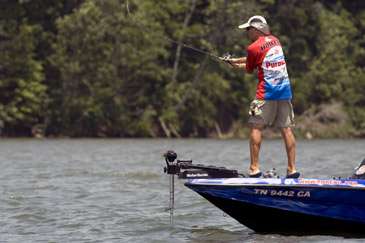
Editor's Note: Our economy is hurting everyone. It's tough these days to make ends meet and still enjoy a few days on the water. But it's important to remember that catching bass isn't about spending money, it's about fishing smart.
In this multipart series top professional anglers will give us their best money saving tips. Applying them to our everyday fishing will help all of us meet our family obligations and still chase bass.
1. Get the most from fluorocarbon line.
Fluorocarbon line is popular because it performs better than monofilament and braid for most applications. As a result it makes fishing more efficient and more enjoyable. But, it has a drawback — expense.
Old fluorocarbon can be refurbished and made good as new in most cases with this simple trick: After you've fished with it for awhile — three or four trips — tie the end of it to a fence or some other sturdy object in your backyard. Stretch it tight and let it stay that way for an hour or so. Then wind it back onto your reel. Make sure it's tight on the spool.
This will take all the memory out of fluorocarbon line without hurting it one bit. After that, all you need to do is cut the end off if it's nicked or scuffed and you'll be good to go without incurring the expense of buying new line or sacrificing quality.
A word of warning: My experience is with Berkley 100% Trilene Fluorocarbon. I know stretching it is effective because it's made with pure fluorocarbon. It may not work quite as well with other fluorocarbon lines.
2. Make use of your electronics.
Instead of running all over the lake and burning a ton of gas and oil looking for a new spot to fish — or making a long milk run to fish all over the place — use your electronics to learn the details of where you're already at.
For example, maybe you've found a ledge that holds good late-season bass. You fish the same spot on that ledge every time you fish that lake. Why not use your electric motor to run the entire length of the ledge and map it with your depthfinder? You might be surprised at what you find.
Another trick used by successful anglers is to break a one or two acre area into a grid pattern. The squares should cover no more than a few square feet. Pass over every inch of the bottom — again, using your electric motor — with your electronics.
Often you'll find an isolated rock or stump that you didn't know was there. And, just as often, that isolated rock or stump will be home to a keeper bass. Doing this doesn't cost you anything except maybe a few pennies for electricity to recharge your batteries.
3. Old lures still catch fish.
You don't need every new, fancy and expensive lure to catch bass. True, many of them are topnotch and perform better than older models, but if you have old baits that are in good condition fish with them. Why spend money on new lures just because there's a fancier one on the market, especially if it hurts your budget?
If you have doubts about this tactic consider the life of a bass. They try to avoid other predators, they eat and they reproduce. They don't think and they don't go to school. They don't learn about lures and they certainly don't get conditioned to lures they've never seen.
Old baits that caught bass 10, 15, 20 or even 30 years ago will do so again if you give them a chance. If fact, many of us who fish the Bassmaster Elite Series pay good money for those old baits when we can find them. We don't do that because we're collectors, we do it because we want to win.
Read The Frugal Angler, Part 2.





